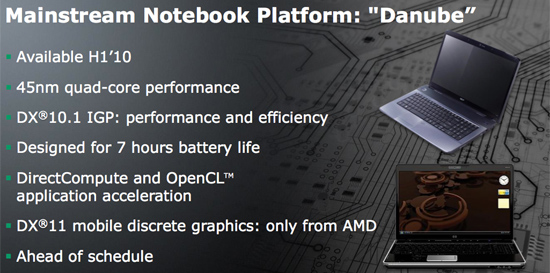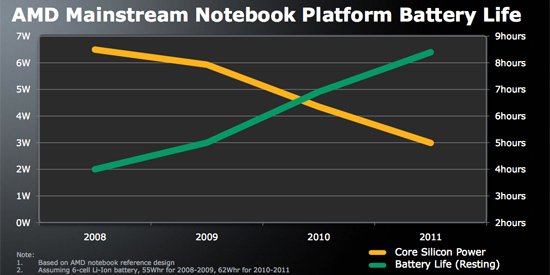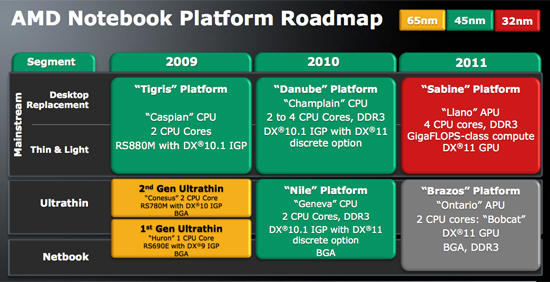AMD's 2010 - 2011 Roadmaps: ~1B Transistor Llano APU, Bobcat and Bulldozer
by Anand Lal Shimpi on November 11, 2009 12:50 PM EST- Posted in
- CPUs
The Notebook Roadmap
For mainstream notebooks today AMD doesn’t really offer anything sexy. We have the Tigris platform based on the Caspian CPU (45nm Athlon II X2 derivative) and RS880M chipset with integrated Radeon HD 4300 series graphics (DX10.1).

Next year we get the Danube platform, complete with Champlain CPU (Athlon II X2 or X4 derivative) and relatively similar graphics to what we have now.
Like the desktop roadmap, things don’t get interesting until 2011; that’s when we meet Sabine.
Sabine comes with a Llano APU, just like the desktop, and four 32nm Phenom II-like cores. There isn’t a dual-core mainstream offering for mobile on the roadmap. Llano of course comes with a DX11 GPU on die, which AMD is calling GigaFLOPS-class. I guess we won’t have 4870 level performance on die at 32nm.
AMD doesn’t have a high performance CPU for ultrathin notebooks today. The only options are Consesus and Huron, both first generation K8 derivatives. They’re also fabbed at 65nm so they’re not exactly as small or power efficient as they could be.

Next year this starts to change with the Nile platform. It comes with a Geneva CPU, a lower power Athlon II derivative. That should help fix the performance issues. At 45nm we’ll hopefully see good battery life from the platform.

Come 2011, AMD has another CPU core for us; it’s called Bobcat. I first talked about Bobcat over two years ago, and we won’t see it for nearly another two years, incredible. It’s an ultra low power microprocessor architecture specifically designed for mobile. Assuming AMD didn’t exaggerate its claims, this should be the first real mobile competitor Intel has seen.

Bobcat will appear in the Ontario APU as a part of the Brazos platform. Hooray for more codenames.

If you look at AMD’s roadmap there are a couple of subtle hints to pay attention to. Note that Brazos extends top to bottom from Ultrathin down to Netbook, whereas no other AMD platform has ever completely gone down to the bottom of the Netbook segment. Could this be an indication of AMD’s ability to hit ultra low, Atom-like, pricepoints with Bobcat?
Secondly - the Brazos platform isn’t colored yellow, green or red for 65nm, 45nm or 32nm. I'm guessing that means Ontario will be built on a bulk 28nm process to save cost.
When I spoke to Globalfoundries earlier this year they indicated that fabbing on half nodes could be one option exploited by CPU companies looking to compete with Intel.










59 Comments
View All Comments
gost80 - Thursday, November 12, 2009 - link
There is no way they are going to have no L3 cache. With a CPU this small anyway, not having L3 is a disaster. L3 will be small area anyway due to it being denser. I agree, no need for it to be 6M. So I would put the cache range 4-8M. 0M? no way.Either ways, expect very budget GPU for the time.
gruffi - Monday, April 19, 2010 - link
Here is a die shot of Llano, http://chip-architect.com/news/Llano_comp2.jpg. A 32 nm design with improved Shanghai cores + RV830 class GPU. No L3 cache.grimpr - Wednesday, November 11, 2009 - link
What our dear Anand clearly seems to forget mentioning is that the Llano APU is a 1st gen FUSION product, Deneb CPU Cores + ATI GPU Cores and not the crap IGP on die that Sandy Bridge delivers. Do the math and speculation Anand...2nd GEN Fusion is Bulldozer Core + Next Gen ATI MIMD GPU Core in 22nm, 2012.
Take care, Anand.
jav6454 - Wednesday, November 11, 2009 - link
AMD keeps throwing tech that is good at thus point, but for me it feels more like catch game to intel. The GPU side seems more advanced but only time will tell.AMD should really stop trying to play catch-up and deliver already.
notposting - Wednesday, November 11, 2009 - link
Don't suppose they'll get off their chipset designing rears and fix their horrendous SB SATA/AHCI implementations? Or stay true to form and just keep rolling the same broken design forward?T2k - Wednesday, November 11, 2009 - link
...seriously: when you are obviously so lousy that you open your AMD-titled article with an Intel picture and then follow up with re-wording of the slides then why bother at all...?You had nothing to say but you screwed up royally with this crap - just post those fuckin' slides someone emailed you and just stay away from your keyboard, we all will be better off.
strikeback03 - Wednesday, November 11, 2009 - link
What I wonder is why does the comments section of an article that presents useful information have to be filled with craptastic comments such as all the ones you have posted?AnandThenMan - Wednesday, November 11, 2009 - link
Article is crap, get over it. People are going to call out the author when he writes pure drivel like this.You think that posting an Intel slide FIRST is really the best way to write an AMD based article? You know who does stuff like that? Biased fanboys with an agenda. We expect more, and expect sites to be professional. The article is not, it's a joke.
Deal with it.
geok1ng - Wednesday, November 11, 2009 - link
AMD lost the entire HTPC/Netbook wave. There was a time when AMD had the best IGP on the market by almost 2 gens gap, but that IGP didnt come with a low power CPU for pairing. When atom and netbooks arrived AMP could put a low power CPU for battle and still won the benchs thanks to the amazing IGP and chipset of the platform, but there never was something like an AMD Netbook...Lets face the truth: we have too much CPU performance already on mobile devices- the last great challenge was BluRay playback, an issue that was solved by better IGPs, not by faster CPUs. But if i go shopping at sub 12 inches Notebooks i cant find anything that gives me the graphics performance of 3 years ago for the price i payed at the time: certainly i have dual-core 45nm CPUs to choose from, but the IGPs are a joke.
The great issue with mobile CPUs are drivers , not raw power requirements: most 45nm C2Ds can do sub 1.0v but the deep C state management of windows are crap, thanks to poor CPU driver investments
yyrkoon - Wednesday, November 11, 2009 - link
( Picture of Tomshardware logo )Anandtechs position as a leading tech /enthusiast review site took a nose dive today when they plastered an Intel Slide right at the top of the AMD roadmap "article". Several Tomshardware readers were shocked as they finally felt right at home on this once highly respected site . .